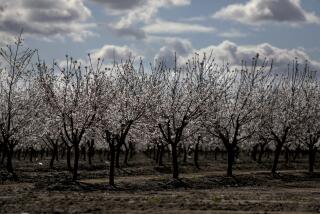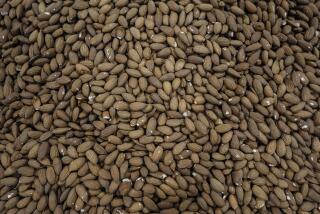PUC to Consider Whether Hulling Almonds Is an Agricultural Process
- Share via
From the tough-nut-to-crack file: When is an almond no longer an agricultural product?
California’s Public Utilities Commission must answer that question today when it takes up an electricity rate dispute between the almond industry and PG&E; Corp.’s Pacific Gas & Electric Co.
Almond hullers -- they separate the fleshy vegetative covering and the hard shell from the nut -- contend that they qualify for the lower agricultural rate that farmers pay for electricity.
The utility, however, charges almond hulling and shelling companies a higher commercial rate, arguing that the process of freeing the nut is a manufacturing technology that changes the form of the almond.
“All we are doing is removing the dirt, sticks, leaves, hulls and shells from the almond,” said Gene Beach, president of the Almond Hullers and Processors Assn. in Merced.
Beach figures that almond hullers could shave 15% to 20% off their electricity bills if they persuade the PUC to grant the lower rate. That would require a majority vote by the five-member commission.
About 70% of California’s $2-billion almond crop is hulled in the PG&E; service territory. The remainder is serviced by small, municipal utilities that already charge lower rates, Beach said.
PG&E; spokesman John Nelson acknowledges that there is “regulatory ambiguity when it comes to some of these agricultural activities,” but he added that the utility’s executives believe hulling and shelling are “food processing that would be charged commercial rates.”
Regulatory decisions have come down on both sides of the issue.
Administrative Law Judge Myra Prestidge rejected an appeal by the almond hullers in October. She ruled that hulling and shelling are akin to pitting peaches and apricots, a food processing activity that changes the nature of the product.
But PUC President Michael Peevey issued his own opinion on the matter this month, pointing out that previously the commission granted cotton ginners the lower rate. Ginning separates cotton fiber and cottonseed and is analogous to hulling and shelling, he said.
Similarly, the PUC ruled that the lower rate should apply to dairy processors that separate raw milk into products such as whole milk, skim milk and cream, he noted.
Almonds have become one of California’s most important agricultural commodities. The nut’s growing reputation as a healthy snack food that benefits the cardiovascular system and metabolism has sent demand soaring. Last year’s harvest reached 1 billion pounds. California accounts for 80% of the world supply.
As their industry has grown, farmers have learned how to get the most out of almonds. Once considered trash, the hulls have become a prime cattle feed product and now are an $80-million annual business.
More to Read
Sign up for Essential California
The most important California stories and recommendations in your inbox every morning.
You may occasionally receive promotional content from the Los Angeles Times.














